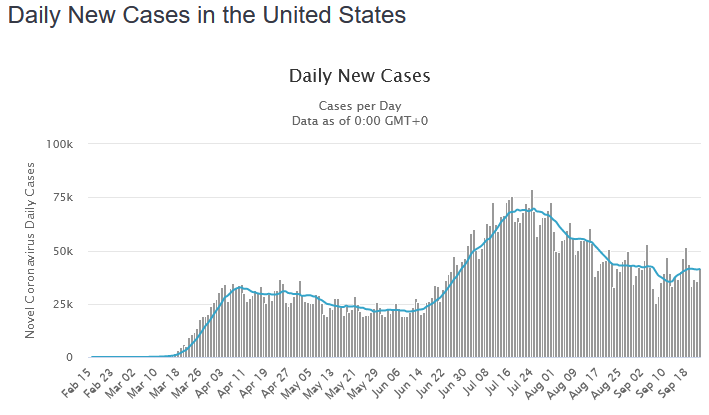Thanks for reminding me to get my flu shot! Booked an appt at minute clinic this morning and just got it. Bad news though the nurse practitioner who gave it to me was super cute and laughed at all my jokes and I think I’m in love so I’m going to need direct exposure to someone with coronavirus so I have an excuse to see her again.
I wonder if we ever get details but clearly USF is thinking their players got it from ND players during their game.
https://twitter.com/slmandel/status/1308889371995766784?s=21
Oh I thought you had played golf with the guy who tested positive.
Perhaps we can convince the pigs to socially distance, or just eat allllllll the bacon.
Here is my 14 day sum of positives case density.
The really bad (high and rising):
AR-MO-ND-NE-OK-SC-SD-UT-WI So mostly the middle of the country leading the pack (of motorcycles???). ND and SD #1 and #2. Coincidence? I think not.
The bad (high-ish and steady-ish)
AL-IA-ID-KS-KY-MT-TN-TX
Note only two democratic governers (KY-WI) but ALL on this list have republican legislatures.
States to keep an eye on: CO-MN-NJ-WY (Three more close to vroom-vroom)
Updated today (9/23)
Nationally there was a case dip earlier this month to 35,000/day, now we are back to about 42,000. Still a little hard to interpret due to the holiday in there. Lots of states with high positive rates, the usual suspects.
Currently thinking ~260k by the election and 320k by EOY (assuming we go into another partial lockdown most places). Note if we climb for a month and then plateau its another 50k so 370k by EOY.
I honestly don’t know how Florida isn’t doing worse. It’s pretty much open for business here in Palm Beach County. Masks are required in restaurants till you get seated or whatever, and restaurants have been pretty packed.
Restaurants with good air circulation seem to be relatively low risk. It’s bars and restaurants with re-circulation that are dangerous.
One thing that may come out of this is office buildings with windows you can actually open. It’s ridiculous that in LA - we have perfect weather like 300 days a year, but almost all office buildings have to run the AC near-year-round - because we’re all in sealed-up greenhouses.
My old job had offices in Rockefeller Center in NYC. You could open the windows! I was like what sorcery is this?
If you don’t test you have less cases. If you have comorbidities you don’t really die of covid.
How many times does this need to be explained?
At this point, it’s clear that cases were down before we opened up the schools, but now they’re holding steady.
Expect an uptick soon. I think the only thing preventing it is that the fast rising current states are less populated. CA going down offsets a lot of growth in the Dakotas but once summer risers fully plateau or start to increase…
And some degree of herd immunity.
Thanks Rand.
What about the weather?
It’s not zero %. Let’s just try to be realistic. There is some degree of herd immunity working in our favor. It’s not like a completely fresh unplowed field.
Weather bad. Back to school bad. College kids coming back home for the holidays bad. Complacency/quarantine fatigue bad.
Some degree of herd immunity, masks, and better treatments are the mitigating factors.
It’s also a not a linear curve. It’s one of those where there is little impact until you are far up to scale. If the true herd number is 75% you won’t have appreciable reduction in transmission rate until you are probably 2/3 of the way there.
I was joking with my Rand comment, thinking you were joking. But if you weren’t joking then I guess neither am I. ???
At this point, we don’t know that yet. Whether COVID19 is seasonal is still a big unknown.
A good read from the SARS outbreak of 2002-2004. Remember that COVID19 is a new zoonotic pathogen:
The SARS coronavirus may have emerged from animal reservoirs to affect human beings as incidental hosts, and may therefore exhibit patterns of recurrence that are difficult to predict. In a similar example, the ebolavirus emerged from a presumed but still unidentified animal reservoir to cause large outbreaks in Zaire and Sudan in 1976 and then largely disappeared until its recurrence 18 years later (figure 2 ).30 The irregular pattern of ebola recurrence since that time indicates that if SARS behaves like a newly emergent zoonotic pathogen it may be difficult to predict when, or if, it will re-emerge.
Influenza behaves both as an established human respiratory pathogen, with predictable seasonal recurrences,31, 32 and periodically as a newly emergent zoonotic disease, when shifted strains emerge from reassortment of avian or other animal influenza viruses to cause pandemics.31 Under the latter circumstance, seasonality is not predictable. The 1918 pandemic swept around the globe without regard to season, and planning for the 1957 pandemic in the USA was severely disrupted when the virus spread months earlier than predicted.15
In a recent example of newly emergent pathogens violating seasonal predictions, the first southern hemisphere occurrence of echovirus type 33, typically a summertime enteroviral infection, occurred in New Zealand during the winter of 2000.33 Illness was unusually severe, the novel seasonal pattern was puzzling, and it remains difficult to predict if or when cases will recur.
I’m not joking. There is almost certainly partial herd immunity at play here. Exactly how much of course is up for debate.

